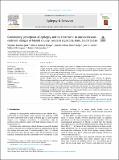| dc.contributor.author | Jada, Stephen Raimon | |
| dc.contributor.author | Tionga, Moses Samuel | |
| dc.contributor.author | Fodjo, Joseph Nelson Siewe | |
| dc.contributor.author | Carter, Jane Y. | |
| dc.contributor.author | Logora, Makoi Yibi | |
| dc.contributor.author | Colebunders, Robert | |
| dc.date.accessioned | 2022-05-28T10:17:17Z | |
| dc.date.available | 2022-05-28T10:17:17Z | |
| dc.date.issued | 2022-01-10 | |
| dc.identifier.citation | Stephen Raimon Jada, Moses Samuel Tionga, Joseph Nelson Siewe Fodjo, Jane Y. Carter, Makoi Yibi Logora, Robert Colebunders, Community perception of epilepsy and its treatment in onchocerciasis-endemic villages of Maridi county, western equatoria state, South Sudan, Epilepsy & Behavior, Volume 127, 2022, 108537, ISSN 1525-5050, https://doi.org/10.1016/j.yebeh.2021.108537. | en_US |
| dc.identifier.issn | 1525-5050 | |
| dc.identifier.other | DOI:10.1016/j.yebeh.2021.108537 | |
| dc.identifier.uri | https://repository.amref.ac.ke/handle/123456789/713 | |
| dc.description | @2021 The Author(s). Published by Elsevier Inc. This is an open access article under the CC BY-NC-ND
license (http://creativecommons.org/licenses/by-nc-nd/4.0/). | en_US |
| dc.description.abstract | Objective
To assess the community’s perception of epilepsy and its treatment in onchocerciasis-endemic villages of Maridi County, Western Equatoria State, South Sudan. The study was conducted prior to the setting up of a community-based intervention to manage the important disease burden caused by onchocerciasis-associated epilepsy in these villages.
Method
Five focus group discussions (FGD) were conducted with community leaders and with persons with epilepsy (PWE) and their families between November and December 2019.
Results
Villages close to the Maridi dam were considered to be most affected by epilepsy. Misconceptions about the cause and treatment of epilepsy were identified. Most people believed that epilepsy is caused by bad spirits and is contagious, transmitted through saliva, air, and contact with PWE. Very few participants were aware of the link between onchocerciasis and epilepsy. Persons with epilepsy are restricted in their day-to-day activities and children with epilepsy are often denied going to school. Persons with epilepsy are stigmatized and seen as unfit for marriage. Most participants considered both traditional and medical treatment as ineffective. Uninterrupted anti-seizure treatment continuously was unaffordable for most families with one or more PWE.
Conclusion
There is a need to establish a comprehensive epilepsy treatment program which addresses misconceptions about epilepsy and reduces epilepsy-related stigma. Explaining the link between onchocerciasis and epilepsy could lead to a reduction in epilepsy-related stigma. | en_US |
| dc.language.iso | en | en_US |
| dc.publisher | Elsevier | en_US |
| dc.subject | Onchocerciasis | en_US |
| dc.subject | Epilepsy | en_US |
| dc.subject | Nodding syndrome | en_US |
| dc.subject | Community | en_US |
| dc.subject | Misconceptions | en_US |
| dc.subject | Focus group discussions | en_US |
| dc.title | Community Perception of Epilepsy and its Treatment in Onchocerciasis-endemic Villages of Maridi County, Western Equatoria State, South Sudan | en_US |
| dc.type | Article, Journal | en_US |

